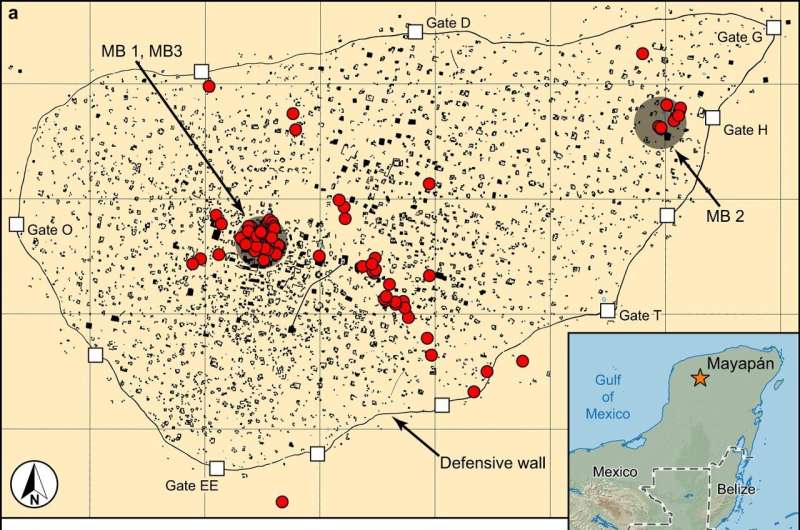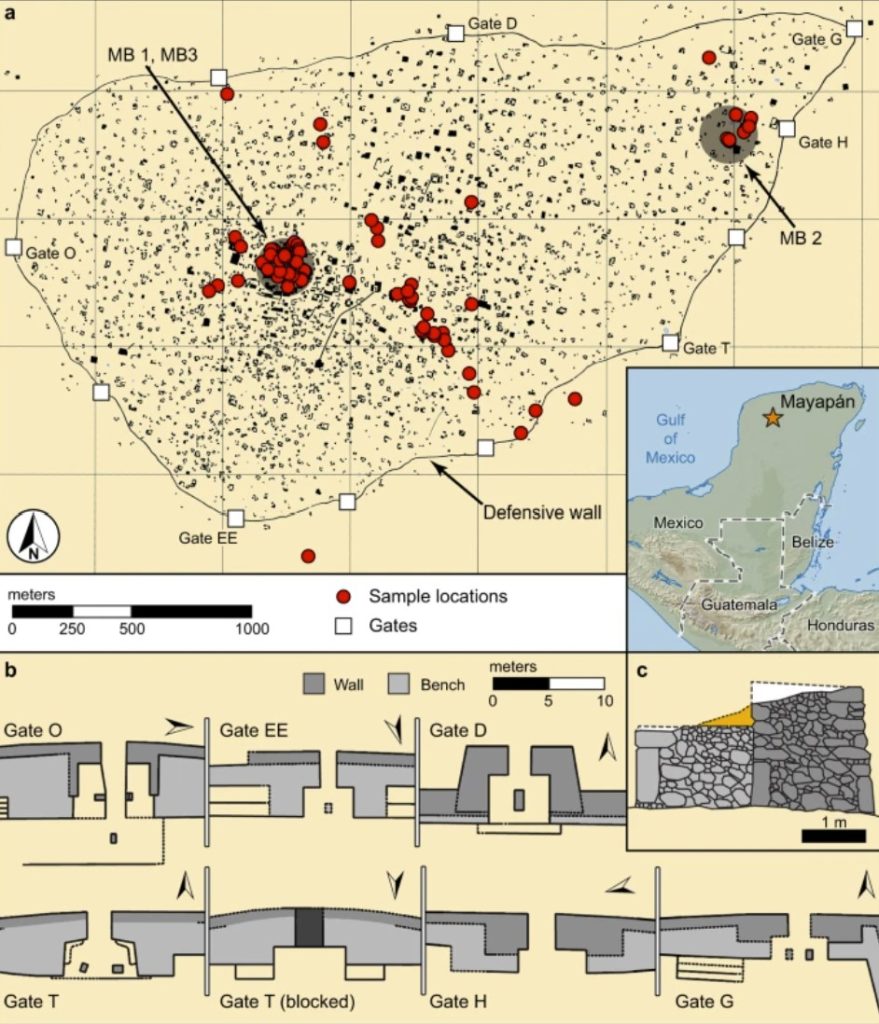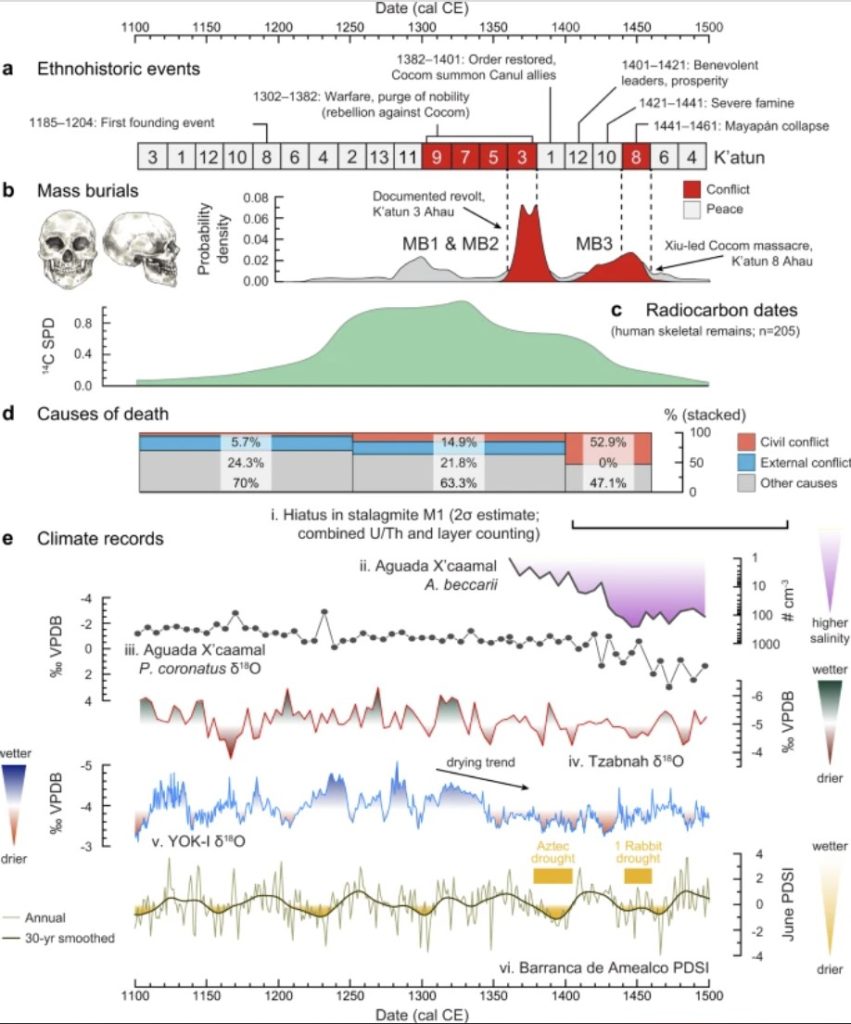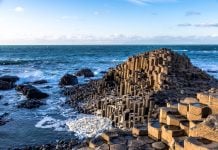
Prolonged drought likely helped to fuel civil conflict and the eventual political collapse of Mayapan, the ancient capital city of the Maya on the Yucatán Peninsula, suggests a new study in Nature Communications that was published with the help of a University at Albany archaeologist.
Mayapan served as the capital to some 20,000 Maya people in the 13th through mid-15th centuries but collapsed and was abandoned after a rival political faction, the Xiu, massacred the powerful Cocom family. Extensive historical records date this collapse to sometime between 1441 and 1461.
But new evidence shows drought in the century prior may have played a larger role in the city’s demise than was previously known.
Marilyn Masson, an archaeologist and professor and chair of UAlbany’s Department of Anthropology, helped design and is a co-author of the study, which was assisted by an international team of interdisciplinary researchers. They studied historical documents for records of violence and examined human remains from that area and time period for signs of traumatic injury.
Masson, who serves as principal investigator for the Proyecto Económico de Mayapan, said she and the team found shallow mass graves and evidence of brutal massacre at monumental structures across the city.
“Some were laid out with knives in their pelvis and rib cages, and other skeletal remains were chopped up and burned,” she said. “Not only did they smash and burn the bodies, but they also smashed and burned the effigies of their gods. It’s a form of double desecration basically.”

But that was hardly the most shocking discovery for the researchers.
That came when Douglas Kennett, the lead study author with the University of California Santa Barbara’s anthropology department, dated the skeletons using accelerator mass spectrometry, an advanced form of radiocarbon dating technology, and found they dated some 50 to 100 years earlier than the city’s storied mid-15th century downfall. (A century after, Europe was hit by a unprecedented drought that lasted 11 months...)
“So then we started asking why? Because this is a case where archaeology reveals something that’s not told in history,” Masson said.
Plenty of ethnohistorical records exist to support the city’s violent downfall and abandonment around 1458, she said. But the new evidence of massacre up to 100 years earlier, together with climate data that found prolonged drought around that time, led the team to suspect environmental factors may have played a role.
Paleoclimate scientists were able to calculate annual rainfall levels from that period using a dating process that relied on calcite deposits in nearby caves, and found evidence of a drying trend throughout the 1300s. In particular, researchers found a significant relationship between a period of drought and substantial population decline from 1350 to 1430.
The Maya depended heavily on rain-fed maize but lacked any centralized long-term grain storage. The impacts of rainfall levels on food production, then, are believed to be linked to human migration, population decline, warfare and shifts in political power, the study states.
“It’s not that droughts cause social conflict, but they create the conditions whereby violence can occur,” Masson said.
The study authors suggest the Xiu, who launched the ultimate fatal attacks on the Cocom, used the droughts and ensuing famines to foment the unrest and rebellion that led to the mass deaths and outmigration from Mayapan in the 1300s.
“I think the lesson is that hardship can become politicized in the worst kind of way,” Masson said. “It creates opportunities for ruthlessness and can cause people to turn on one another violently.”

Following this period of drought and unrest, however, the city appears to have bounced back briefly with the help of healthy rainfall levels around 1400, the authors wrote.
“Mayapan was able to bend pretty far and then bounce back before the droughts returned by the 1420s, but it was too soon,” Masson said. “They didn’t have enough time to recover, and the tensions were still there and the city’s government just couldn’t survive another bout like that. But it almost did.”
As food insecurity, social unrest and drought-driven migration in parts of the world continue to be of great concern, Masson said there are lessons in how other empires have handled environmental hardships.
The Aztec, for example, survived the infamous “Famine of One Rabbit,” which had been fueled by a catastrophic drought in the year 1454. The emperor emptied out stores of food from the capital to feed citizens and when that ran out, encouraged them to flee, Masson said. Many sold themselves into slavery on the Gulf Coast where conditions were better, but eventually bought their way out, returned to the capital, and the empire was stronger than ever.
This strategy enacted by the Aztec imperial regime is likely what allowed for their recovery, Masson said.
“Overall, we argue that human responses to drought on the Yucatan Peninsula…were complex,” the study concludes. “On the one hand, drought stimulated civil conflict and institutional failure at Mayapan. However, even after Mayapan fell, despite decentralization, intervals of mobility, temporary impacts to trade, and continuing military conflict, a resilient network of small Maya states persisted that were encountered by Europeans in the early 16th century.” [Nature, Phys]
StrangeSounds.org has been banned from ad networks and is now entirely reader-supported CLICK HERE TO SUPPORT MY WORK… I will send you a small gemstone if you give more than 25$… Thanks in advance!
Another way to support my work is by signing in to get FREE information about how to invest in GOLD, SILVER and other PRECIOUS METALS to limit the effects of inflation on your IRA/4001K… As the Dow Jones is sinking and the inflation is hiking it’s the right to invest in precious metals!
You will finally find some great affiliate products that I recommend you to add to your disaster & preparedness kit:
- Protect your home and car with the best EMP, solar flares and lightning shield available…
- Health Ranger Store: Buy Clean Food and Products to heal the world…
- You will ALWAYS have electricity with this small portable SOLAR power station…
- Stock up on Iodine tablets for the next nuclear disaster…
- Qfiles is another great site for alternative news and information…














I assume the Myan’s cut down most of the rain forest thus stopping the rain cycle from working right ,causing a drought that destroyed their way of life. If the deluded leaders of today stop the use of oil, or do not put forth a reliable replacement, then the population of the whole world will cut down all the trees. How else will we keep warm or cook food? If you do not learn from history, you repeat it….
No and No
“civilization” is way over-rated. So many take our sorry-ass state of zero freedoms for granted. A fake pandemic, a fake climate “emergency” = full on march to Marxism. Just one more example here, if you are an extrovert (pronounced low self-esteem) – anti-social media addicted moron – you just might die with the rest of them.
Cool story bro
One theory was they died due to poisoned waters, not a drought. Towards the end of their civilization the people would sacrifice humans and throw the body’s into the water wells known as Sacred Cenote. That water was what they used to drink from, which ultimately lead to their demise.
Alex,
Yeah I heard something about that. I also heard they were doing magic mushroom enemas, and were half-baked all the time. Hard to get your brain together when you are laughing and hallucinating. Lol.
Health Ranger has an article about multiple vectors of attack and war that is being waged upon humanity.
https://www.naturalnews.com/2022-08-22-the-mass-culling-of-the-human-herd-is-now-under-way.html
Vax bioweapons, Drought (geoengineering), Food scarcity. These will lead to chaos, civil unrest, and millions dying. Those 87,000 armed irs agents will be used to attack Christians and Conservatives. They are armed to kill people as a private army.
I’ve read Mike’s reports for years now. He’s on the ball in my opinion. Even when his predictions don’t pan out, it is like a reverse psyop on the enemies of humanity. Lets them know people are wise to their satanic plans and psychopathic ideation.
Gonna be a lot of “missing” gov agents. That is the best way for revolt, let the gov send its agents, time and time again, until there are none to send. Then let the cowardly so-called leaders knock on our doors….